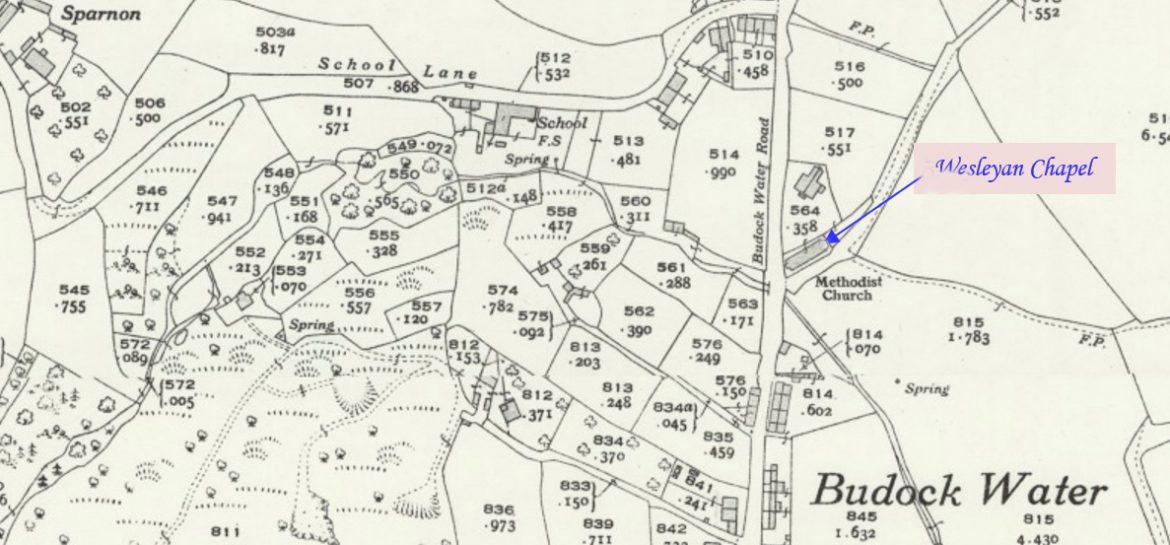
Budock Water is two miles west of Falmouth. This profile of Budock Water Wesleyan Chapel has been compiled by Jo Lewis and Tony Mansell.
Located in School Hill.
Wesleyan chapel, disused at time of survey. Rebuilt or considerably remodelled in 1897. Stuccoed walls with rusticated quoins and moulded hoods (over dressed granite plinth at the front); grouted scantle slate roof. 3-bay front gable with centre broken forward; round-arched openings; fanlight head to larger central window. Gabled porch to right-hand return elevation. Low granite rubble forecourt wall with dressed granite copings (b1). (Cornwall Council Heritage Gateway)
1814 Chapel
Circa 1814: Wesleyan Methodist Chapel build date. (Wikipedia)
1843 Chapel
Circa 1843: Wesleyan Methodist Chapel rebuilt. (Wikipedia)
1845: Build date. (Cornwall Council Heritage Gateway)
Built as a Wesleyan Chapel. (SWChurches)
1883: “BUDOCK. The renovation of the interior of Budock-water Wesleyan Chapel is rapidly making progress, and according to the appearance of the woodwork, which being prepared entirely by Mr. George Rogers, at his establishment, the completion will doubtless give general satisfaction. The architect has already expressed his approval of what has been done.” (Lake’s Falmouth Packet and Cornwall Advertiser – Saturday 04 August 1883)
1898 Chapel
 Budock Water Wesleyan Chapel (Photo: Jo Lewis 2021)
Budock Water Wesleyan Chapel (Photo: Jo Lewis 2021)
1897: Building re-modelled. (Cornwall Council Heritage Gateway)
1898: “NEW WESLEYAN CHAPEL AT BUDOCK. Opening Ceremony. The small and dilapidated chapel which used to serve the purposes of the Wesleyan community at Budock, near Falmouth, has given place to a building of bright and modern aspect, capable of accommodating close upon 300 people, the old portion being utilised for a Sunday-school. The chapel is a stone building, stuccoed, and resting on a granite base. Lightness and taste characterise the arrangement of the interior. Usually the rostrum is placed in the middle of one end of a chapel, but custom has been broken in this respect. A large panelled and moulded timber screen adorns the end wall, and the rostrum is located in a corner, from which the preacher can see every face in the congregation. Beneath the wooden reredos is a sunken niche, which accommodates the communion table. The appearance of the chapel is greatly enhanced by large circular windows with cathedral tinted glass. Opening proceedings took place on Friday, and were attended by many friends from Falmouth and locality belonging to the Wesleyan and other Nonconformist bodies… Mr. J. Olver gave the history of the chapel scheme, which was initiated in 1805. The building contract was £396, re-seating £27, cartage £40, architect’s fees £25, extras, £20; total £508. An estimate for an enclosure outside the chapel would bring the whole cost up to £550. He was pleased to say that farmers in the neighbourhood had done the cartage gratuitously, and Mr. W. H. Tresidder, who prepared the plans and superintended the work generously declined to accept any payment (applause). Deducting the amounts included for those two items, and taking the sum raised to date, they were left with about £230 to raise. He could see the way to securing about £100 in the coming year, so that the debt remaining on the building would not be very heavy (applause)…” (Royal Cornwall Gazette – Thursday 07 April 1898)
Old building utilised as Sunday school.
1923: “The annual tea of the Wesleyan School took place at Budock on Wednesday. Mawnan Brass Band played selections.” (3 August 1923 – Western Morning News)
1932: The Wesleyan, Primitive Methodist and the United Methodist Church amalgamated to become the Methodist Church of Great Britain.
1932: Became Budock Water Methodist Church. (SWChurches)
1940: Seating for 160. (David Easton, Methodist Minister and historian)
1949: Certificate of registration, marriages, Budock Methodist Church. (Kresen Kernow MRF/540)
1894-1951: Trust minutes, Budock Methodist Church. (Kresen Kernow MRF/326)
1970: Certificate of registration, Budock Methodist Church. Certificate of registration as place of religious worship. (Kresen Kernow MRF/541)
1952-1989: Minutes, trustees, property committee and church council, Budock Water Methodist Church. Signed minutes, annual and special meetings of trustees, 1952-1977; property committee, 1977-1979 and church council, 1980-1989. At front of volume list of names of managing trustees. Stuck in volume: letter sanctioning new heating from the Methodist Church Department for Chapel Affairs, 1953; newspaper cutting about the first marriage conducted at the church, 1956; photograph of electric organ, 1955. (Kresen Kernow MRF/1149)
1989: Closed. (SWChurches / David Easton, Methodist Minister and historian)
Became a restaurant. (David Easton, Methodist Minister and historian)
Declining congregations eventually resulted in this chapel being closed (1989) and sold, and that building was used as a meadowy restaurant and is now a carvery.
